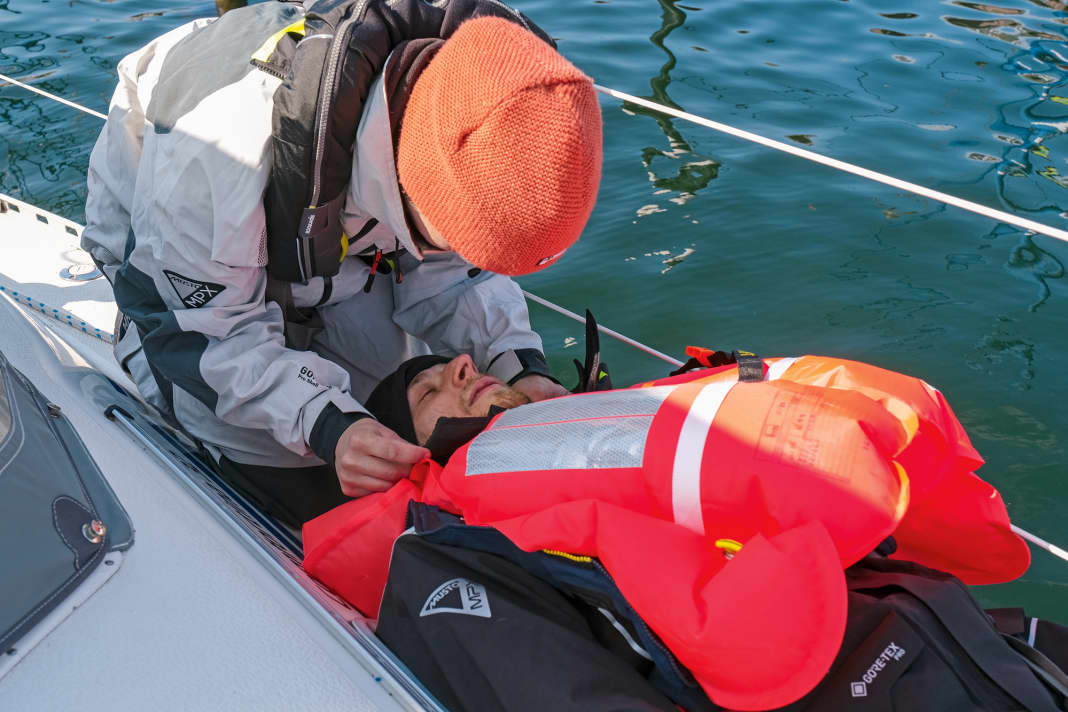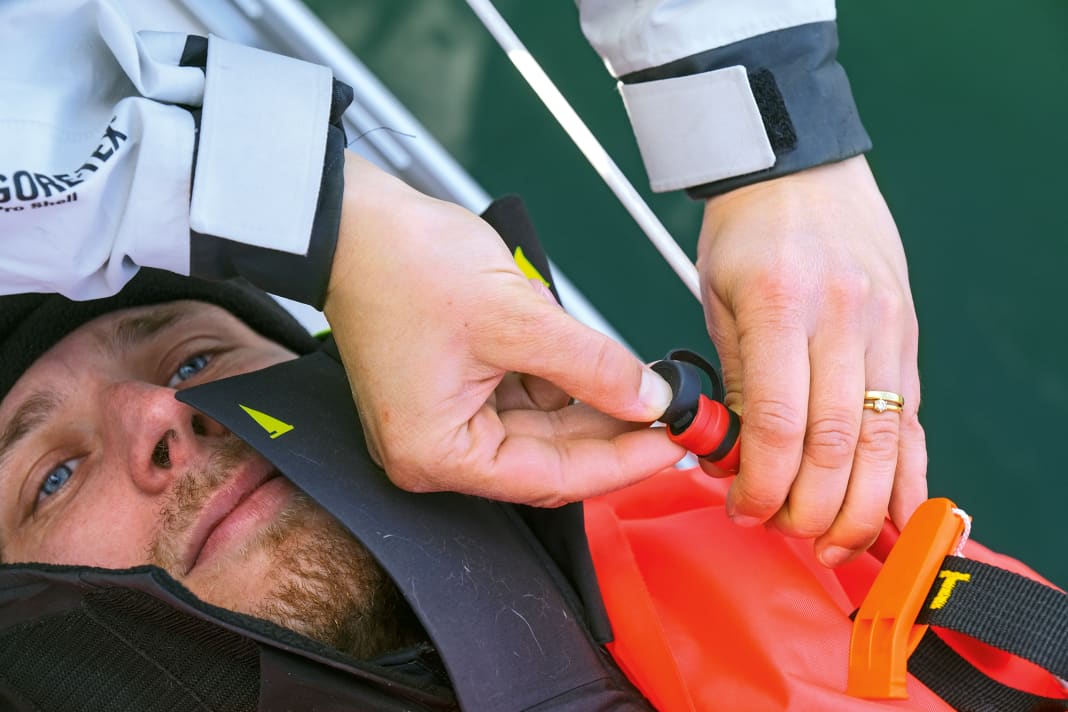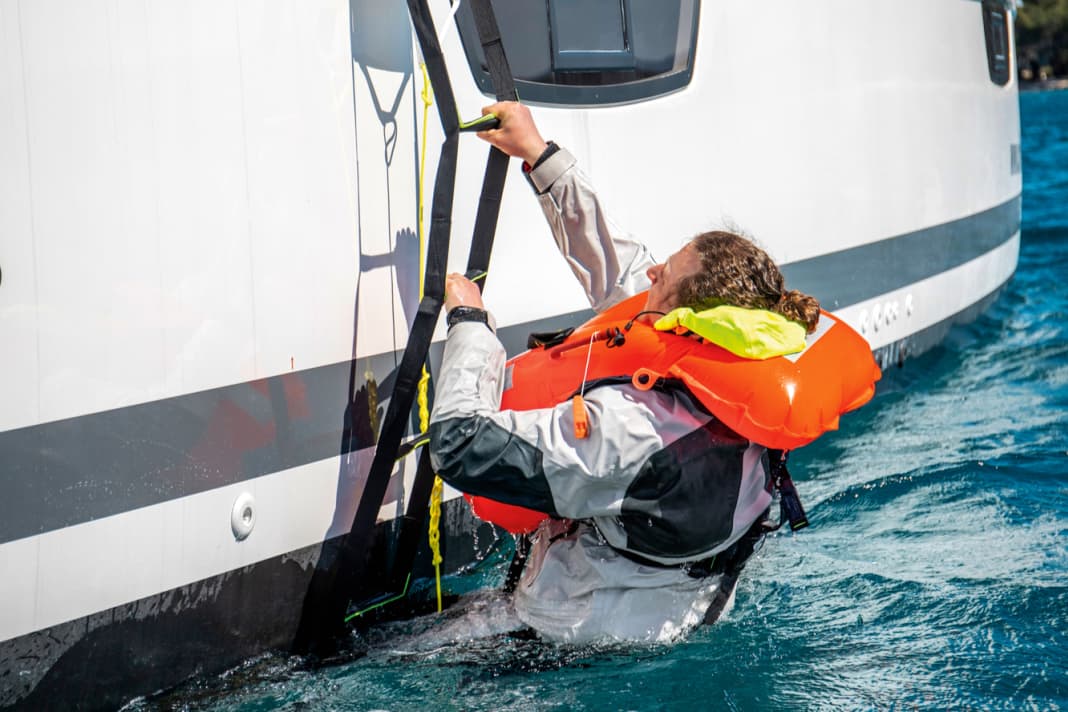





Sailors love the water, but don't necessarily have to get closer to it than the freeboard between the cockpit and the surface. In summer, a dip in the water is pleasantly refreshing, but in spring too much contact can be dangerous or even fatal.
Just how dangerous can be seen in the Case of the skipper of the "Speedy Go" who fell overboard in the Flensburg Fjord at the beginning of April last year. The training vessel, a Salona 44, had set off on a heavy weather cruise when the foresheet became snagged during a jibe at Marina Minde and the skipper fell overboard while clearing. He was not wearing a lifejacket and was not on a leash.
The crew managed a MOB manoeuvre and a line connection was established with the skipper floating in the water, but the mobile swim ladder was not immediately clear. Once the crew had attached it, the skipper was unable to climb it. A crew member who had climbed into the water to assist was unable to bring the now immobile skipper into the cockpit with the help of the crew on board.
After just a few minutes, it took a great deal of effort to get the second person in the water (wearing a lifejacket) back on board. The rescue team, which arrived about 30 minutes later, could only recover the skipper dead and took the previously rescued co-sailor, who was hypothermic, to hospital. His core body temperature was 32 degrees Celsius. This was despite the fact that his fellow sailors had removed his wet clothing below deck and warmed him with several blankets - the water in the fjord was still very cold at five degrees Celsius. He survived the tragic incident.
MOB manoeuvre is the start of further rescue measures
Cold water is extremely treacherous. The example of the accident on the "Speedy Go" shows two things at once. Firstly, the rapid loss of mobility makes swimming impossible; without a lifejacket, you hardly stand a chance. And secondly, even if a crew member is rescued from the water, their life may still be at risk due to hypothermia. The MOB manoeuvre is therefore only the beginning of further rescue measures.
If a crew member falls into cold water without a survival or dry suit, a sequence of bodily reactions begins that can be helpful in preparation and rescue. We were supported in technical questions by the physician and sea rescuer Jens Kohfahl. We also refer to his book "Medicine at Sea", which is well worth reading.
The body goes through several phases until hypothermia sets in
Sea rescuers regard water temperatures below 15 degrees Celsius as cold and below 10 degrees Celsius as very cold. Water conducts heat 25 times better than air. So if you fall into cold water without protective clothing, you will cool down much faster than in the cold wind. According to expert Kohfahl, there are four phases that the organism goes through after falling off the boat: TheFirst phase is the cold shock reaction. The body reacts to the cold stimulus with a deep breath, followed by hectic hyperventilation. The greatest danger here is inhaling water and drowning. This phase only lasts for a short time, between one and three minutes.
This is followed by thesecond phase. The cold causes a decline in nerve and muscle function. The expert speaks of swimming failure. This occurs after about ten minutes. Fine motor skills become difficult even before this, after which the person is no longer able to stay afloat under their own steam, let alone climb a rescue ladder.
Thethird phase is hypothermia or hypothermia. Depending on the water temperature and the physical condition of the person in the water, hypothermia sets in after around 30 minutes. The arms and legs cool down first, the blood vessels contract due to the cold stimulus and stress, and the extremities are no longer sufficiently supplied with blood. If the core body temperature falls below 35 degrees, experts speak of hypothermia. This phase can also be further subdivided. More on this later. The hypothermic person can survive for up to two hours at a water temperature of five degrees. The prerequisite for this is a lifejacket with a spraycap that prevents fainting.
TheFourth phase is the so-called rescue collapse. The hypothermic crew member is only kept alive by a minimal circulatory system. Heart rate and blood pressure are therefore greatly reduced. External influences can disrupt this fragile circulatory function, for example if the patient is moved too much. A horizontal position is advisable and slow movements are preferable. However, this gets in the way of rescue measures. It has to be quick, a horizontal rescue is not always possible. And how is the MOB to be brought below deck into the warmth if he is not to be moved if possible?
Act carefully and effectively in the event of hypothermia
This dichotomy must be resolved as best as possible in the situation on board. It is impossible to do everything right, "but if you leave a fellow sailor wet and hypothermic on deck, he probably won't survive either," says Jens Kohfahl. Now is the time to act as carefully but also as effectively as possible.
The first step is to make an emergency call if this has not already been done in the MOB situation.
A crew member who has been in cold water for 30 minutes is considered hypothermic."
The crew remaining on board can also seek help via radio medical advice. This involves a quick assessment of the situation. If the rescued person is still responsive and trembling, this is a good sign that theFirst phase of hypothermia has only just begun. In the second phase, the core body temperature drops to 32 to 28 degrees. The patient appears unconscious and is no longer shivering.
In the third phase, the patient is even colder and unconscious, but still breathing. In the fourth phase of hypothermia, the core temperature has fallen below 24 degrees. The patient is unconscious and has no heartbeat. However, even experts find it difficult to feel the slight pulse of a hypothermic patient. Therefore, laypeople should not waste time searching for the pulse. A hypothermic person can still be rescued for a relatively long time. Once close to land, you can head for the harbour or wait for the rescue services. A rescue foil with one shiny gold and one shiny silver side also helps a little over wet clothing. Ideally, the soaked clothes should be removed. If a larger crew is available to help, the patient can be taken below deck. If he is even mobile under his own power, he should be helped to walk below deck. Overexertion can also lead to circulatory collapse, but with a small crew this may be the only option. A quick decision must be made here, as the soaked crew member will continue to cool down on deck in wet clothing.
Helping a hypothermic co-sailor below deck






For better manoeuvrability, first deflate the inflated lifejacket. To do this, the elongated bulge on the lid of the red mouthpiece is pressed into the valve from above and held in place. With an inflated waistcoat, you can barely make it into the cockpit or through the companionway.
Below deck, the hypothermic co-sailor must then be placed on the saloon bench or on the floor if the ship is moving strongly. The wet oilskin should not be cut up; the functional clothing will still be needed later, far from land. The jacket can be rolled up under the back, pulled over the head from behind and then the sleeves pulled off towards the feet. The trousers can also be removed with a little effort. The wet clothing underneath is more difficult to remove. Pullovers and T-shirts can be cut open quickly. Then dab the patient with a towel. Do not rub! The patient is warmed up in the so-called hypothermia wrap. To do this, place a warm blanket over the dried patient. Also try to push this under the patient at the sides. A rescue sheet is placed over this and then another sleeping bag or further blankets. The final layer is a tarpaulin, a sail or another rescue sheet so that everything is protected from water, for example if a fellow sailor with wet oilskins bends over the person wrapped up.
During this time, it is important to constantly speak to them, but not to calm them down. On the contrary, the stress level should be kept high. Circulation-maintaining stress hormones such as adrenaline help. "Stay with me! Don't go to sleep! It's not over yet!" If the hypothermic person relaxes too much now, the weak circulation threatens to collapse for good. Talking to them, keeping them awake and observing them is very important. If the patient is conscious, hot tea can also help. Hot water bottles can also help to warm the patient up. However, do not place the hot bottle on bare skin, as there is a risk of burns! Alcohol is not recommended. The substance dilates the blood vessels and causes blood pressure to drop dangerously. There is a danger to life! If the patient suddenly stops breathing, start resuscitation immediately. Depending on the severity of the hypothermia, this may still be the case some time after the rescue.
Another source of danger is inhaled seawater. The osmotic gradient of the salt causes fluid to escape from the lung tissue and fill the lungs. This is the body's attempt to dilute the salt content, but it can be fatal. Because there is a risk of drowning. This process is not directly related to hypothermia, but can still be life-threatening even 24 hours after the rescue. Medical care is therefore also advisable in less serious cases.
Good preparation for an emergency case of hypothermia helps
At best, good preparation helps to avoid an emergency with a person in the water. In the case of the "Speedy Go", the BSU investigation report that it was a chain of many problems that led to the skipper's death. Starting with the lack of manoeuvring arrangements. If the sheet had not snagged, nobody would have had to go to the forecastle. Nevertheless, it is not always possible to avoid going to the foredeck and there is no danger with the right equipment. A safety line and a stretch rope prevent falling overboard.
And if a crew member does fall into the water, only a lifejacket can help at low temperatures. This is because swimming failure, the second phase of hypothermia, begins after just a few minutes. There is still enough time to rescue the person. However, if they are not wearing a lifejacket, they will drown first. The lifejacket must also be unconscious-proof, and it is important that it is put on correctly. So take some time at the start of the trip to adjust the straps. The lifejacket must fit as snugly as possible and crotch straps must be worn.
Equipment and rescue systems for emergencies






The next problem on board the "Speedy Go" was a bathing ladder that was not immediately ready for use. If this has to be retrieved from the forecastle first, valuable moments pass in which the person in the water might still be able to get back on board under their own steam. This is where an emergency ladder, which is already attached to the pushpit and can be quickly unfolded, can help. If the person can no longer get out of the water under their own power, special rescue systems can help. We have already tried out various rescue collars, the Catch & Lift system and rescue nets in previous articles. Not all of these aids need to be on board, but at least one that the crew has already practised with in the best case scenario.
Don't forget the lift loop on the lifejacket. A halyard can be hooked into this belt loop (it must say "lift" on it, not simply hooked into any belt strap) and the person can be winched on deck without any other aids. With a helper in the water, as in the case described, this is also possible without the assistance of the MOB. The disadvantage, however, is that the upright position with the chest crushed by the harness is not ideal for a person suffering from hypothermia. This is why sea rescuer and doctor Jens Kohfahl has a rescue net on board. It is attached to the handrail on the superstructure roof and extends over the railing into the water. It provides support and is also suitable for horizontal rescue.
Enclosure as a helpful manoeuvre
A helpful manoeuvre is to lie alongside, which gives you time to care for the hypothermic person. Alternatively, this can also be done using an autopilot and travelling slowly.
In any case, it is worth getting help, because it is difficult to assess the condition of a hypothermic person. And even if you can avoid many mistakes during the rescue, some contradictions cannot be resolved. The biggest mistake, however, is to underestimate the effect of cold water.

